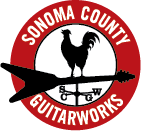We see some weird stuff in the shop from time to time, but this one is a doozy:

It’s so nice of the boys over at Takamine to help us out like this – how else would we have known which way to turn the truss rod? (For the record, we chose to “warp” the neck.)
This does bring up a good point. though: terminology is important when describing what’s going on with your guitar. We try to speak as plainly as possible with musicians who come in to our shop, in hopes that the point doesn’t get lost amidst the technical jargon. Aristotle did say that “language was the beginning of misunderstanding”, but he didn’t say anything about pictures, so we thought we’d take a moment to try to illustrate how a truss rod works and what terminology is used when discussing neck problems. We’re going to say something that could be said about 100 different ways, so if you’ve heard it said differently, pick the version that you like best!
A neck strung up to pitch is typically under around 220 pounds of pressure or so, and most guitars have a truss rod to help counteract the string tension and to put the neck into the proper amount of relief. (Relief is the measure of space between the bottom of the string and the 6th fret when fretted at the 1st and 13th.) Usually a guitar neck should have between .006 and .008 of relief in order to allow the string to vibrate freely without any buzzing. Too little relief and the straightness of the neck will cause the low register notes to buzz and fret out, too much relief and the curvature of the neck causes high action in the middle of the scale, and the guitar becomes difficult to play. If the action is set comfortably on a neck with excessive relief, the strings will often fret out in the upper register as they encounter the end of the fingerboard.
We say a neck is bowed when it has too much relief:

To take out relief, tightening the truss rod is *usually* the solution (sometimes truss rods break, strip out, or otherwise don’t function properly – don’t adjust your truss rod unless you’re absolutely SURE you know what you’re doing!).
A neck is back-bowed when it is bent the opposite direction:

To add relief, the truss rod is loosened.
Adjusting the truss rod is just one component of a proper setup, and isn’t the end-all solution to a poorly playing guitar. If your guitar has playability issues, chances are it’s going to need more than a simple truss rod adjustment. When in doubt, ask us. Send us an email at [email protected], or call the shop (415.865.5424), or just drop by. We’re here to help!


